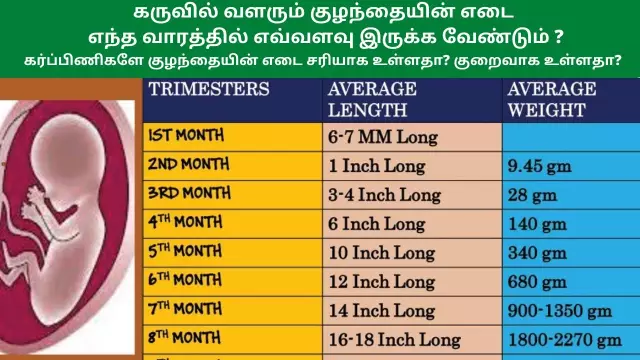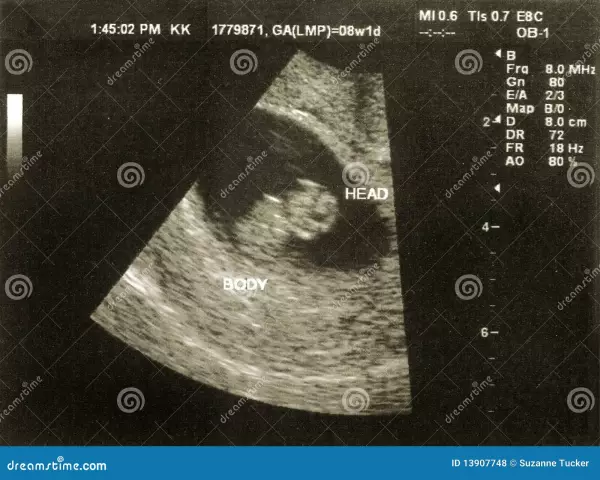- Author Rachel Wainwright [email protected].
- Public 2023-12-15 07:39.
- Last modified 2025-11-02 20:14.
10 weeks pregnant

At the 10th week of pregnancy, the age of the unborn baby is 8 weeks from the moment of conception. With the onset of the 10th week of pregnancy, the second crisis stage of the relationship in the mother-fetus system passes.
Fetal changes
The size of the fetus at 10 weeks of gestation is about 35 - 40 mm in length, and the weight reaches 5 g, that is, in size it already corresponds to a small apricot. Up to half the length of the fetus falls on the head, but there are no traces of the tail at all, it has turned into a tailbone.
The fetal heart rate at 10 weeks of gestation is about 150 - 160 beats per minute, that is, almost like that of a newborn baby.
At this time, the arms and legs of the future baby have already been formed, one can distinguish between his knee and elbow joints. The fetus has been actively moving for a long time, its movements become more diverse, although they are not felt by the woman. Mimicry develops - the fetus opens and closes its mouth, brings its hands to the face, grimaces and grimaces, puts its fingers in its mouth.
The hair on the head of the future baby is still missing, but the whole body begins to be covered with light fluffy hair - lanugo.
At the 10th week of pregnancy, the nerve cells of the brain multiply intensively, the entire nervous system by this time was divided into central and peripheral. It is from the age of 10 weeks of pregnancy that the electrical potentials of the fetal brain can be recorded, indicating its activity.
The development of the immune and lymphatic systems continues, the intestines are almost completely formed. The external genital organs begin to form, but on ultrasound at 10 weeks of pregnancy, the sex of the fetus cannot yet be distinguished. The sex glands begin to produce hormones.
Changes in a woman's body at 10 weeks of gestation
At the 10th week of pregnancy, the manifestations of early toxicosis in the form of nausea, vomiting and profuse salivation are significantly reduced. The organisms of the mother and the fetus have almost completely adapted to coexistence. But weakness, fatigue, distraction and mood swings may persist.
The belly at the 10th week of pregnancy has not yet rounded, although the uterus is comparable in size to a grapefruit, and it becomes cramped in the small pelvis. Sometimes the enlargement of the uterus provokes frequent urination and constipation. But these are temporary problems, as soon as the uterus enlarges so much that it leaves the pelvic cavity, they stop.
On the abdomen at 10 weeks of pregnancy, some women have a dark thin strip that goes to the bosom from the navel.

A pregnant woman at 10 weeks with severe toxicosis sometimes loses weight, but most often from that moment on there is a weight gain, no more than 2 - 3 kg. During pregnancy, a woman's weight increases not only due to the growing uterus, fetus and amniotic fluid. The increase is given by adipose tissue, which is deposited in the thighs, abdomen, and chest. Thus, the body stores nutrients for future breastfeeding of the baby.
Discharge at 10 weeks of gestation should not be a cause for concern if it is yellowish or whitish, and does not have an unpleasant odor. In the event that the discharge at 10 weeks of gestation is abundant, cheesy, crumbly and accompanied by itching or burning, then they may be a sign of thrush (vaginal candidiasis). It is quite common during pregnancy, which is associated with a change in acid-base balance, hormonal shifts and a decrease in immunity. If you have thrush, you should consult your doctor about treatment, as taking certain medications during pregnancy may harm your unborn baby.
Pain at 10 weeks of pregnancy should alert a woman. If they are accompanied by bloody discharge, this may be a symptom of an ongoing miscarriage.
Examination at 10 weeks of gestation
Usually, ultrasound at 10 weeks of pregnancy is prescribed for all women as a screening study. With a normal pregnancy, this is the first ultrasound examination of the fetus, according to its results, the number of fetuses, their movements and heartbeats, gross anomalies and malformations are judged. Detection of fetal malformations incompatible with life at such an early stage of pregnancy may become an indication for its termination. Ultrasound at 10 weeks of gestation confirms the viability of the fetus and specifies the gestational age.
An important examination at the 10th week of pregnancy is a blood sugar test. It must be taken on an empty stomach. It is especially important to conduct a blood test for sugar in pregnant women over 25 years old, with overweight or hereditary diabetes mellitus. Pregnancy puts a significant load on all organ systems of the female body, and in people from risk groups, diabetes mellitus often begins during this period.
YouTube video related to the article:
Found a mistake in the text? Select it and press Ctrl + Enter.






